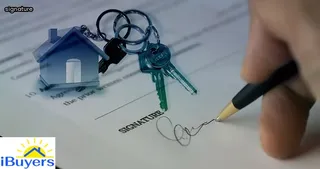A Maryland quitclaim deed is a legal document that transfers ownership of real estate from one person to another. It differs from a warranty deed in that the seller does not guarantee title to the property.
This can be beneficial if an owner needs to quickly transfer ownership without dealing with any potential title issues. A quit claim deed also requires less paperwork and fewer steps than other types of deeds, making it easier for owners to transfer their property rights to another person or entity.
Additionally, using a quit claim deed may provide some tax advantages, as it eliminates the need for paying capital gains taxes on the proceeds of the sale. For these reasons and more, a Maryland quitclaim deed can be an attractive option for those looking to easily transfer ownership of their properties.

Completing a Maryland Quit Claim Deed for a house can be easily achieved by following the required steps. The deed must be drafted in accordance with Maryland law and executed in compliance with the State’s regulations.
In order to create a valid quitclaim deed, the document must include information such as the legal description of the property, the names of all parties involved, and an acknowledgement of consideration provided by the grantor. Furthermore, it is important to note that Maryland deeds are not self-proving; therefore, they must be notarized and witnessed in addition to being recorded in the Circuit Court Clerk's office.
Additionally, all parties should keep copies of their signed documents for future reference. To ensure accuracy when drafting and executing a Maryland Quit Claim Deed, it is best practice to consult an attorney or other legal expert who can provide advice on any applicable rules or laws.
Completing and submitting a Maryland Quit Claim Deed is not difficult but it does require attention to detail. First, the deed must be signed by all owners of the property, as well as a notary public.
All signatures should match those on the deed of trust or other legal documents pertaining to the property. The deed should include a description of the property in question, including any relevant information such as lot numbers or acreage.
It is also important to provide your contact information, such as phone number, address, and email address. Once completed, the deed needs to be submitted to the local county clerk's office for recording.
Filing fees may apply and can be paid at this time or with a check sent with the document. Be sure that you have included two copies of the quitclaim deed when submitting it for recording; one will be returned after filing has been completed.
It is important to keep these documents safe in case they are needed in future reference. Finally, once filed and recorded correctly, you can rest assured that your Maryland Quitclaim Deed has been officially filed and recognized by your local government office and is binding on all parties involved.

A Maryland Quitclaim Deed is often used when transferring ownership of a home from one person to another. It may be necessary in situations such as payment of a debt, settling an estate after the death of an owner, or when gifting property to someone else.
When multiple owners are involved, a Quitclaim Deed is often used to transfer title from one co-owner to another. In addition, it may be used for adding or removing individuals from existing deeds and for changing the legal description of a property.
A Maryland Quitclaim Deed is also commonly used when refinancing a home loan or during a divorce settlement. Furthermore, it is important to keep in mind that this type of deed does not provide any warranties or guarantees on the title of the property being transferred.
Finding the right resources to create your Maryland Quitclaim Deed is essential for successfully completing this important legal document. It's important to understand that although the process may seem intimidating, with the right tools and information it can be completed easily.
Doing research online to find reliable resources is a great place to start. Many websites offer free templates and helpful guidelines that are specific to Maryland requirements.
Additionally, local county offices will have forms available and can provide assistance if needed. Speaking with a lawyer or real estate agent who is familiar with quitclaim deeds in Maryland can also be beneficial.
Having access to the most up-to-date laws and regulations will ensure you have all the necessary information to complete your deed correctly. It's also wise to consult multiple sources for advice, as well as double check any paperwork before submitting it for final approval.
Taking the time to use quality resources when creating your Maryland Quitclaim Deed allows for a smoother process and can help ensure everything is done properly the first time around.

Completing a Maryland Quitclaim Deed for a house can seem daunting, but with just a few simple steps, the process can be made easy. Before beginning, make sure to contact your county's circuit court office to ensure that all necessary documentation is in order and ready to be filed.
After this step is complete it is important to obtain the deed form from either your local real estate office or online. Once you have obtained the form it is important to fill out all necessary fields including names of grantor and grantee as well as address of property.
When signing the deed, make sure that all parties present sign in front of at least one witness and a notary public who will also need to sign for proper execution. Make sure that all information is accurately reflected on the deed and any errors are corrected prior to filing with the court clerk's office.
This should be done as quickly as possible after signing so that no additional complications arise due to a lapse in time between signing and filing. With these tips, successfully executing your Maryland Quitclaim Deed should be simple and straightforward!.
In addition to a quit claim deed, other documents may be necessary when transferring the title of a house in Maryland. A deed of trust is usually required if there is a loan associated with the property.
The deed of trust must be signed by both the lender and borrower and notarized. A settlement statement or closing statement should also be signed by both parties, which will detail all fees related to the sale of the property.
When dealing with two or more owners, an executed copy of the Deed of Joint Tenancy must also be included. Any taxes that are due on the property at the time of transfer must be paid before filing any documents with the state.
Lastly, it may also be necessary to obtain an affidavit from either a previous owner or lien holder in order for it to be accepted for filing.

There are a number of reasons why you may choose to use a Maryland Quitclaim Deed when completing the transfer of ownership of a house. The primary benefit is that it is much faster and more cost-effective than other methods, such as through the court system.
Furthermore, it allows individuals to easily transfer property without involving third parties or having to go through lengthy legal processes. Additionally, it prevents any potential disputes that could arise from either party being able to prove ownership rights.
Another advantage is that it enables the transferor and transferee to retain their respective interests in the property, ensuring neither party has any claims against one another after the deed has been completed. Finally, using a Maryland Quitclaim Deed is relatively uncomplicated in comparison to other forms of transferring real estate ownership, making it a preferred option for those who want an efficient and hassle-free transaction.
If you need some help completing a Maryland Quit Claim Deed for your house, the process doesn't have to be difficult. It can actually be quite simple if you know where to look.
Start by doing your own research: visit the Maryland Land Records website and read up on their instructions and requirements for filing a quitclaim deed. You should also contact an experienced real estate attorney who specializes in deeds and titles, as they can provide valuable guidance throughout the process.
Additionally, you may want to consider visiting your local county courthouse to see what resources are available that could help make the process even easier. Finally, if all else fails, don't hesitate to ask for assistance from a professional title company or surveyor who is familiar with Maryland Quit Claim Deeds—they will be able to walk you through everything step by step and ensure that everything is done properly.
With the right preparation, completing a Maryland Quit Claim Deed can be a straightforward task.

If you are having trouble filing or recording your Maryland Quit Claim Deed for a house, there are a few steps you can take to make the process easier. The first step is to make sure you have all the necessary documents and paperwork ready before beginning the process.
This includes the Quit Claim Deed itself, proof of payment, proof of ownership, and any other relevant documents. Once these documents are ready, you will need to find out where to file in Maryland.
To do this, contact your local Clerk of Court office and ask which courthouse handles quitclaim deeds in your county. You may also need to obtain a certified copy of the deed from the Register of Wills office.
After finding out where to file and obtaining any required documents, you will need to complete the Quit Claim Deed form accurately with all relevant information for both parties involved. Finally, be sure to double-check all details before submitting your deed for filing or recording as mistakes can cause delays in processing.
Following these steps should help ensure that your Maryland Quitclaim Deed is completed and filed without any major issues.
Completing a Maryland Quitclaim Deed requires several fees to be paid in order to finalize the transaction. First, there is a transfer tax that must be paid when recording the deed with the state.
It is based on the sale price of the property, and it varies depending on which county it is located in. Second, there are also fees associated with having the deed notarized.
These can vary depending on what type of notary services you choose to use, but they generally range from $5 - $20. Finally, if you hire an attorney or title company to handle the paperwork for you, there may also be additional administrative costs associated with their services.
It's important to be aware of all of these costs before beginning the process so that you can budget accordingly and avoid any surprises down the line.

Filing a Maryland Quitclaim Deed for a house is an important legal process, and it's important to do it correctly. Although mistakes are common when creating and filing this document, some steps can be taken to avoid them.
First, make sure the deed is signed in front of a notary public or an authorized individual so that it can be legally binding. Additionally, ensure all information provided on the deed is accurate and up-to-date.
When filling out the document, take special care to provide all parties' full names, addresses and other relevant details correctly. Furthermore, check with your local clerk's office to find out what fees may be applicable and if there are any other documents that need to be included with the quitclaim deed upon filing.
Finally, double-check that any applicable deadlines have been met before submitting it to the county court for processing. Following these tips will help you complete your Maryland Quitclaim Deed easily while avoiding common mistakes.
Completing a Maryland Quit Claim Deed (MDQD) without following all of the rules and regulations could have serious consequences. Not including all of the required information in the deed, such as names, addresses, and legal descriptions, can result in an invalid MDQD.
Additionally, failing to properly notarize or record the deed may cause further complications. It is also important to note that if any of the parties involved are minors or do not have capacity to contract, a court order may be required for the conveyance to be valid.
Furthermore, not executing the deed correctly can affect any existing mortgages or liens on the property. Therefore, it is essential to ensure that all of these steps are followed when completing a MDQD for a house in order to avoid potential consequences down the road.

Before using a Maryland Quit Claim Deed (MDQD) for transferring ownership of a house, it is important to prepare yourself by consulting an expert. A qualified real estate professional such as a lawyer, title company representative, or real estate agent can provide advice on the best way to complete the quit claim deed and help ensure that all steps are taken properly.
Additionally they can answer any questions you may have about the process. It is also wise to research the deed requirements specific to Maryland and make sure all necessary documents are ready in order to speed up the process.
This includes gathering information such as the current deed holder's name and address, preparing a description of the property including its location and size, and ensuring that both parties involved in the transfer sign off on the document. Taking these steps ahead of time will help ensure that completing a MDQD for transferring ownership of a house is done correctly and efficiently.
When it comes to completing a Maryland Quit Claim Deed (MDQD) for a house, many people are unaware of the alternatives available and their associated pros and cons. Some of these alternatives include transferring property through a warranty deed, trust or even an affidavit in lieu of title.
A warranty deed is typically used when there is clear title to the property being transferred, as it guarantees that the seller has good title to the estate being conveyed. A trust may be used when two or more parties are involved in the transfer, while an affidavit in lieu of title may be used if no documentation exists to prove ownership.
Each of these methods offer different advantages and disadvantages over using a MDQD, such as cost savings and potential risks. Additionally, some states may have additional requirements for completing transfers using these alternative methods that should be taken into account when considering which option is best for you.

When considering a Maryland Quit Claim Deed (MDQD) for a house, it is essential to understand a few key points before obtaining legal advice. Firstly, the property must be located in Maryland, as MDQDs are only applicable to this state.
Secondly, the deed should be witnessed by two individuals and notarized by an authorized notary public. Next, all parties involved should have an understanding of what exactly the deed is transferring and any associated responsibilities that come with it.
Lastly, there should be an understanding of the taxes due on the property and if any additional documentation is needed to complete the process. All of these considerations must be reviewed before obtaining legal advice on MDQDs in order to ensure that everything goes smoothly when completing the deed.
State and local laws play an important role in determining how a Maryland Quit Claim Deed (MDQD) for a house is completed. Depending on the jurisdiction, different regulations may be in place that can impact the process of completing an MDQD.
For example, some areas require signatures to be notarized, while others do not. Additionally, there are certain forms that must be completed and submitted to the county clerk or other relevant agencies in order for the deed to be valid.
It is important to familiarize oneself with applicable state and local laws prior to starting the MDQD process. Furthermore, understanding what documents are required and how they should be submitted can help ensure that the Quit Claim Deed is processed accurately and efficiently.
Knowing any special requirements specific to one's area of residence will be beneficial when trying to complete a Maryland Quit Claim Deed for a house easily.

Filing a Maryland Quit Claim Deed (MDQD) for a house is an important process for transferring ownership. This type of deed is sometimes used when a homeowner wishes to transfer their property rights to another party without making any warranties about the title or ownership of the property.
With recent updates to the MDQD process, it's easier than ever to complete this legal transaction in Maryland. Homeowners must first obtain the correct quit claim form from their county's Register of Wills office and fill out the necessary information, including details about the grantor, grantee, and property address.
After completing the form, it must be signed by both parties in front of a notary public and then filed with the county clerk or recorder's office where the property is located. Homeowners should also make sure they have all applicable documents related to title or ownership in order to ensure that everything is correctly recorded.
By understanding these latest updates on MDQDs and how they affect you, you can easily complete your quit claim deed for a house in Maryland.
In Maryland, completing a Quit Claim Deed to transfer title of a house requires certain information including the grantor and grantee names, legal description of the property, signature of the grantor, notarization of the signature and county recording information. Additionally, the property must be identified by its street address and associated tax identification number.
The county where the property is located will also require payment for any applicable recording fees. It is important to use a deed that complies with Maryland law in order to properly complete this transaction.
Once all the necessary documentation has been completed, it can then be recorded in the county land records office and will become part of public record.

In Maryland, a quit claim deed can be prepared by an attorney, title company, or real estate agent. The process is relatively straightforward and does not require any special certification.
However, it is critical that all parties involved to be aware of the terms of the deed before signing it, as it is a legal document that transfers ownership rights from one party to another. An attorney may provide guidance in understanding the complexities of the quit claim deed and ensure that all necessary documents are completed correctly and accurately.
A title company or real estate agent may also help ensure that all parties are represented and understand their rights under the deed before signing it. Ultimately, each situation will require individualized attention to assure compliance with Maryland law and complete the quit claim deed correctly.
Yes, Maryland does have a quit claim deed. A quit claim deed is a legal document that transfers ownership of real estate property from one person to another.
The process for completing this type of deed in Maryland is simple and straightforward. First, the grantor (the person transferring the property) must fill out and sign the quit claim deed form.
This form must include the name and address of both the grantor and the grantee (the person receiving the property). Additionally, it must include a legal description of the property being transferred.
Next, two witnesses should be present while signing the deed and they must also provide their signatures as well as their contact information. Lastly, both parties should have their identification verified by a notary public before submitting the document to their local county office for recording.
Following these steps will ensure that all paperwork is in order when transferring ownership of a house in Maryland via a quit claim deed.
Changing the deed on your house in the state of Maryland is a simple process when done with a Quit Claim Deed. A Quit Claim Deed is a legal document used to transfer property from one person (the grantor) to another (the grantee).
To complete the Quit Claim Deed, start by gathering all of the necessary information and documents such as an accurate description of the property, names of the parties involved, and signatures from all parties. Once you have all of this material together, fill out the form with details such as date, name, address and legal description of property.
Have all parties involved sign and date the deed in front of two witnesses and a notary public who will provide their official seal. Finally, record or file the deed at your local county clerk's office or recorder's office.
By following these steps you can easily change the deed on your house in Maryland with a Quit Claim Deed.
A: In Maryland, the deed required to transfer legal title of a house is typically a General Warranty Deed. This type of deed provides the greatest protection for both buyer and seller because it guarantees that the seller holds clear title to the property and that he or she has full authority to convey it. A Title Deed may also be used, however it does not provide as much assurance that the seller holds valid Property Title.
A: A married couple must both sign the quit claim deed in front of a notary public, and provide proof of their marital status with either a marriage certificate or current driver's license. The deed must be filed with the local county clerk's office to be officially recorded.

A: In order to complete a Quit Claim Deed on a house in Maryland, you must first obtain the form from your local Circuit Court Clerk's office. The form should be filled out and signed by all parties involved, and then it should be notarized. Once the deed is notarized, it should be recorded at the Clerk's office.
A: In Maryland, the four types of tenancy available when completing a quit claim deed on a house are Tenants in Common, Joint Tenants, Tenancy by the Entirety, and Tenancy in Common.
A: A co-tenant can complete a quit claim deed on a house in Maryland by filing the necessary paperwork with the county clerk's office and providing proof of ownership or authorization to make the transfer.

A: To easily complete a Quit Claim Deed on a house in Maryland, you must first determine the type of tenancy available. Typically, tenants in common and joint tenancy with right of survivorship are the two most common types of tenancy available when completing a Quit Claim Deed on a house in Maryland.
A: Property owners in Maryland should be aware that a quit claim deed is used to transfer the ownership interest in real property from one person or entity to another. In order for it to be legally valid, it must include the names of all parties involved, a description of the real estate being conveyed, and both parties must sign it before a notary public. Additionally, there are several types of tenancy available when completing a quit claim deed on a house in Maryland such as joint tenancy, tenancy by entirety and tenancy in common.
A: To complete a quit claim deed on a house in Maryland, you must first gather the necessary documents, then complete the deed form, sign the deed in front of a notary public, and finally file the deed with the county clerk.